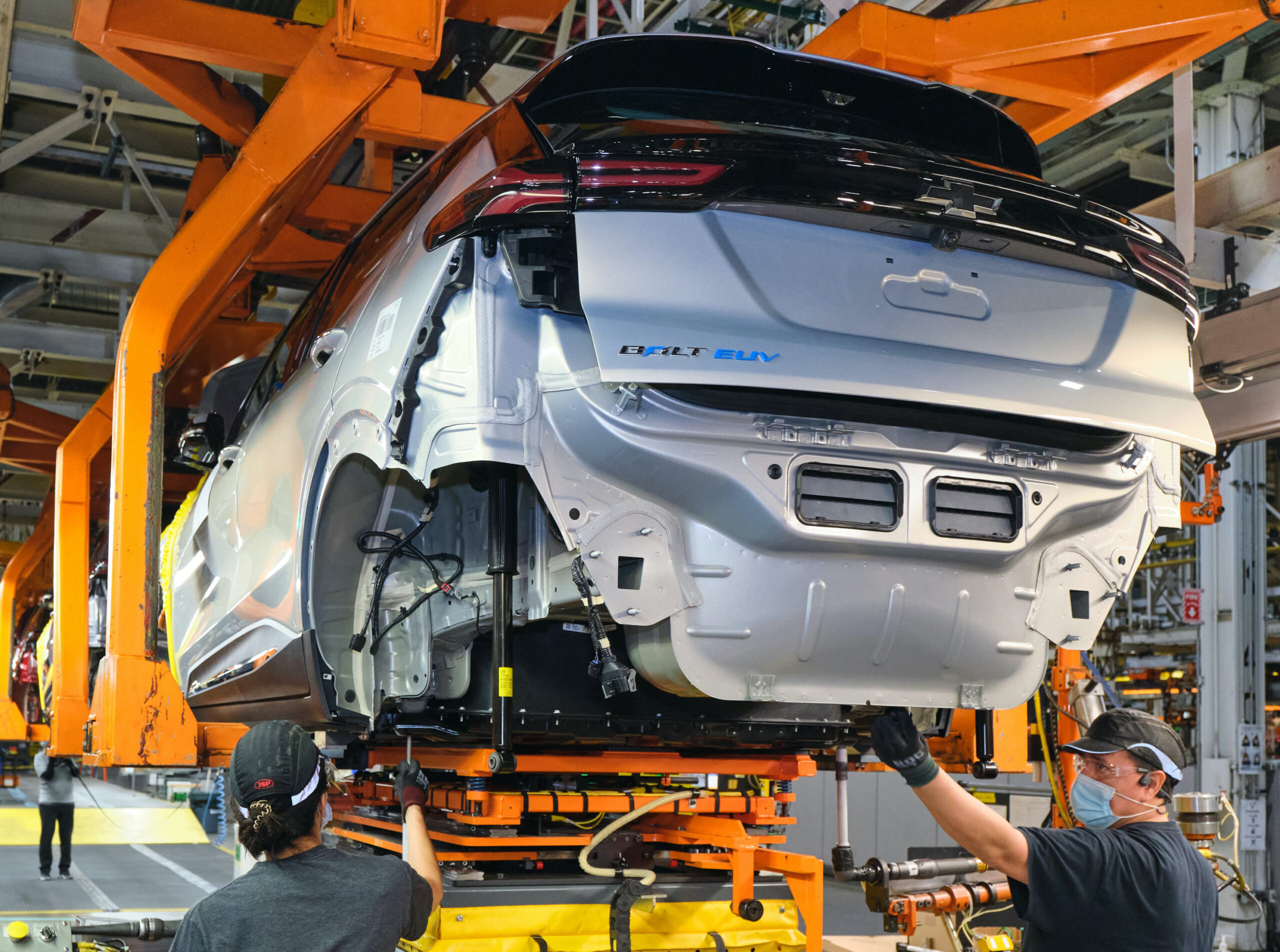

EV tax credit boost: At up to $12,500, here’s how the two versions compareEV tax credit boost: At up to $12,500, here’s how the two versions compare
An expansion of the EV tax credit, which has seen bipartisan support before, has been on President Biden’s CO2-cutting tasklist since before he was elected. Now, as part of a massive $3.5 trillion reconciliation spending bill, the credit faces an uncertain future.
The expanded credit, earlier in the year seen as a shoo-in for one of these large bills, has met harsh criticism in recent days. Legacy automakers are sharply split on messaging, mostly over the inclusion of measures that align with a Biden priority that EVs be union-made and U.S.-built.
UAW-made sticker on 2022 Chevy Bolt EV
The union-made qualifier has been the subject of much criticism, but companies also appear to be alleging a higher sticker price for EVs. Toyota, in a letter to Congress that sharply breaks rank from the positions of other legacy automakers, decided to frame its objections to the extra $4,500 for union-made models included in the House version—or the extra $2,500 in the Senate version—as a handout to the wealthy. The statement largely aligns with a Wall Street Journal editorial calling it “green welfare for the rich.”
To clarify, buyers of non-union-made or imported EVs would still receive the $7,500 tax credit, with some new constraints. But they wouldn’t be eligible for the bonus. The way the Senate version is written, buyers of the Chevy Bolt EV would be eligible to receive a $12,500 credit.
That has a set of automakers crying foul. Autos Drive America, an advocacy organization representing 12 foreign automakers, including Toyota, Honda, Volkswagen, and others, called the union-made boost unfair and “an insult to American auto workers.” That group points out that 90% of today’s EVs would be put at a disadvantage by the perk.
EV tax credit support – Climate Nexus, May 2019
The $7,500 EV tax credit, called 30D by the IRS, is currently the biggest consumer incentive put forward by the federal government to foster the acceptance of electric vehicles, and multiple surveys have found broad support across political affiliations.
But a measure of fairness is missing from the current version, too, as not everyone is eligible for it. To claim the full amount, you’ll need at least that much tax liability for the year. And buyers of EVs from Tesla and GM can’t claim the credit because these companies have already hit a ceiling of 200,000 qualifying vehicles.
Between the House and Senate versions of the revamped EV tax credit, multiple factors could potentially be included in a final, reconciled version. The House version, for instance, includes a $500 bonus for EVs with a battery pack made domestically, while the Senate version doesn’t include that.
Tesla factory, Fremont, California
The House version also has a number of particulars that reel in the amount—including a $400,000 cap on adjusted gross income of those who can claim the credit, and lower MSRP caps for eligible EVs. As such, it would cost dramatically less to implement, as it narrows the incentive down with various limitations, while the Senate version would funnel twice as much funding toward EV incentives over the next decade.
That would result in “significantly more EV deployment and emissions reduction” for the Senate version, says the Zero Emission Transportation Association (ZETA), a policy group that represents electric vehicle makers including Tesla, Lucid, and Rivian, plus a broad swath of utility, battery, and charging interests.
First customer Rivian R1T (from Rivian CEO RJ Scaringe via Twitter)
ZETA, which pushes more broadly for the Senate terms—including a credit that doesn’t time out or hit a ceiling until EVs are 50% of all annual U.S. passenger vehicle sales—argues that income caps actually, counterintuitively, harm lower-income buyers as they make it difficult to simply apply for the credit at the point of sale.
Furthermore, according to ZETA, the caps to MSRP might force automakers to make models that have a lower driving range and are ultimately less desirable, which, it argues, “diminishes the consumer experience and will slow EV adoption.”
ZETA recently helped round up all these details in one place, and we present that to you in a chart here:
Senate vs. House versions of EV tax credit reform – data from ZETA, compiled by GCR
One other key difference: The House Bill currently creates a used EV credit, whereas the Senate version doesn’t. That provision might help quell opposition from the oil industry, which has argued that the credit only benefits those who can afford new and typically more expensive vehicles.
“It is a mistake to think that electric vehicle consumer incentives are ‘goodies’ for the first driver,” said Daniel Zotos, ZETA’s communications director. “Rather, these consumer incentives will deliver substantive environmental, public health, and economic benefits to all Americans.”
Zotos added: “We should not unnecessarily narrow these EV consumer credits to block out certain consumers or manufacturers at the price of limiting climate, public health, and economic benefits.”
The White House
This isn’t the first time an expansion of the EV tax credit nearly reached the finish line. A bipartisan-approved version of the proposal—with different numbers—was cut out of a massive $1.4 trillion spending bill in December 2019, due to “extreme resistance” from then-President Trump.
Will union automakers, non-union automakers, full-line legacy companies, and EV makers all be able to come to an agreement with lawmakers? That’s left to the machinations of Capitol Hill, and it needs to happen soon. Compromise might not be easy, but it could be the key to greater EV adoption.
View original article at: “https://www.greencarreports.com//news/1133669_ev-tax-credit-boost-how-the-versions-compare”
Add a comment Cancel reply
Comments (0)
토렌트
… [Trackback]
[…] Read More to that Topic: autoseu.com/ev-tax-credit-boost-at-up-to-12500-heres-how-the-two-versions-compareev-tax-credit-boost-at-up-to-12500-heres-how-the-two-versions-compare/ […]
Related posts


Electric SUVs: Top 6 Models for Family Trips











